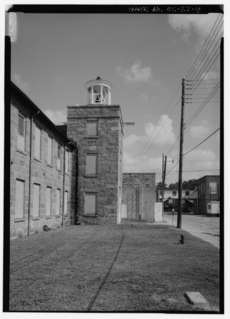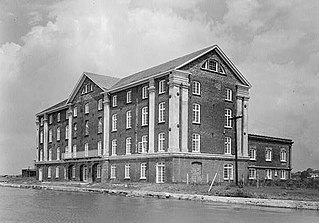
Robert Mills, a South Carolina architect known for designing both the first Washington Monument, located in Baltimore, Maryland, as well as the better known monument to the first president in the nation's capital, Washington, DC. He is sometimes said to be the first native-born American to be professionally trained as an architect. Charles Bulfinch of Boston perhaps has a clearer claim to this honor.

The Charles Pinckney National Historic Site is a unit of the United States National Park Service, preserving a portion of Charles Pinckney's Snee Farm plantation and country retreat. The site is located at 1254 Long Point Road, Mount Pleasant, South Carolina. Pinckney (1757-1824) was a member of a prominent political family in South Carolina. He fought in the American Revolutionary War, was held for a period as prisoner in the North, and returned to the state in 1783. Pinckney served as a delegate to the constitutional convention where he contributed to drafting the United States Constitution.

Middleton Place National Historic Landmark is a plantation in Dorchester County, directly across the Ashley River from North Charleston and about 15 miles (24 km) northwest of Charleston, in the U.S. state of South Carolina. Built in several phases during the 18th and 19th centuries, the plantation was the primary residence of several generations of the Middleton family, many of whom played prominent roles in the colonial and antebellum history of South Carolina. The plantation, now a National Historic Landmark District, is used as a museum, and is home to the oldest landscaped gardens in the United States.

The Fireproof Building, also known as the County Records Building, is located at 100 Meeting Street, at the northwest corner of Washington Square, in Charleston, South Carolina. Completed in 1827, it was the most fire-resistant building in America at the time, and is believed to be the oldest fire-resistant building in America today.

Henry River Mill Village is a small textile village in Burke County, North Carolina. It is an unaltered but now-decaying example of an early industrial environment in Burke County. Today the remaining buildings of the Henry River mill village are traces of the industrial heritage of the county.

The William Aiken House and Associated Railroad Structures make up a National Historic Landmark District in Charleston, South Carolina, that contains structures of South Carolina Canal and Railroad Company and the home of the company's founder, William Aiken. These structures make up one of the largest collection of surviving pre-Civil War railroad depot facilities in the United States. The district was declared a National Historic Landmark in 1963.

The Charleston Historic District, alternatively known as Charleston Old and Historic District, is a National Historic Landmark District in Charleston, South Carolina. The district, which covers most of the historic peninsular heart of the city, contains an unparalleled collection of 18th and 19th-century architecture, including many distinctive Charleston "single houses". It was declared a National Historic Landmark in 1960.

The Graniteville Historic District encompasses one of the first textile company towns to be established in the Southern United States. Built in the late 1840s by William Gregg near Aiken, South Carolina, and now known as Graniteville, it was modeled after New England mill towns. Gregg used the success of this enterprise to advocate for the industrialization of the South, laying the groundwork for its eventual domination of the American textile industry. The district, which includes the original canal, mill building, mill worker housing, and a period church, was designated a National Historic Landmark District in 1978.

The Charleston, South Carolina studio of sculptor Clark Mills, was his first—he worked there from 1837 to 1848, when he moved to Washington, DC. The Charleston studio was designated as a National Historic Landmark in 1965. Before it became Mills' studio, the building, located at 51 Broad Street, Charleston originally served as a tenement house, and now houses professional offices.

St. Michael's Episcopal Church is a historic church and the oldest surviving religious structure in Charleston, South Carolina. It is located at Broad and Meeting streets on one of the Four Corners of Law, and represents ecclesiastical law. It was built in the 1750s by order of the South Carolina Assembly. It is listed on the National Register of Historic Places and is a National Historic Landmark.

The Old Marine Hospital is a historic medical building at 20 Franklin Street in Charleston, South Carolina. Built 1831–33 to a design by Robert Mills, it was designated a National Historic Landmark in 1973 for its association with Mills, and as a high-quality example of Gothic Revival architecture. The hospital was built as a public facility for the treatment of sick sailors and other transient persons.

St. Philip's Church is an historic church at 142 Church Street in Charleston, South Carolina. Its National Historic Landmark description states: "Built in 1836, this stuccoed brick church features an imposing tower designed in the Wren-Gibbs tradition. Three Tuscan pedimented porticoes contribute to this design to make a building of the highest quality and sophistication." On November 7, 1973, it was added to the National Register of Historic Places and designated a National Historic Landmark.

West Point Rice Mill is a former rice mill building in Charleston, South Carolina. It is at the City Marina at 17 Lockwood Drive. West Point Mill was one of three large rice mills in Charleston in the 19th century. This building was constructed in 1861 to replace a rice mill that had burned the previous year. It was named to the National Register of Historic Places on January 20, 1995.

Mills Mill was a textile mill in Greenville, South Carolina (1897-1978) that in the 21st century was converted into loft-style condominia. The building is listed on the National Register of Historic Places.

Pacolet Mills Historic District is a national historic district located at Pacolet, Spartanburg County, South Carolina. It encompasses 126 contributing buildings and 1 contributing site in the mill village of Pacolet. Pacolet Mills village that was laid out and built in 1919, with most worker and supervisor houses were built between 1915 and 1920. Also located in the district are the Pacolet Mills Cloth Room and Warehouse, Pacolet Mill Office, and two churches. The three main Pacolet Mills and a fourth mill (1894) were demolished in the late 1980s.

Brandon Mill, now the West Village Lofts, is a historic textile mill complex, situated just west of the city of Greenville, Greenville County, South Carolina. The mill was built during the early decades of the 20th century and is one example of the mills in the Greenville "Textile Crescent" that became central to the economic development of the South Carolina upstate during this period. The complex was listed on the National Register of Historic Places in 2014, and the main mill has been converted into loft apartments.

Thomas F. Lloyd Historic District is a national historic district located at Carrboro, Orange County, North Carolina. The district encompasses 25 contributing buildings developed as housing for textile mill workers associated with the 1910 Thomas F. Lloyd Manufacturing Company. The district's buildings date between 1910 and 1915 and are primarily one- and two-story frame mill worker dwellings. A notable dwelling is located at 214 Maple Avenue, which was reportedly built by Thomas Lloyd as a "guest house" for the mill.

The Standard Oil Company Headquarters are a cluster of historic commercial buildings at 1600 Meeting Street in Charleston, South Carolina. The main building is a distinctive commercial take on Charleston's residential architecture, with a two-story porch wrapping around its north and west sides. The three buildings were built in 1926 for the Standard Oil Company of New Jersey, housing management and other facilities associated with the adjacent Charleston Refinery.

The Union Village Historic District encompasses the core of a historic 19th-century residential mill village in Manchester, Connecticut. Radiating north and west from the junction of Union Street and North Main Street, the area was developed in the first half of the 19th century has a company town, but evolved into a mixed working-class community in the 20th century. It was listed on the National Register of Historic Places in 2002.























